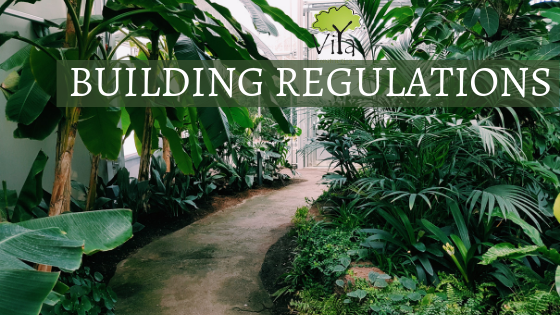Buildings and Buildings Everywhere!
If you live in any of the prominent Indian cities, then this is no alien talk to you. Every corner you wander off to, there is either a building or an upcoming building.
Building Regulations Amendment: Everything you must know!

The recent years saw the rise of an innumerable number of buildings in the country. However, this rise came through with the building regulations letting its guard down. The harsh truth is that most of these buildings out there, touching the skies, are not following any of the building regulations.
Is it absolutely necessary to follow Building Regulations?
Yes, it definitely is! Each one of these building regulations has been laid down to make sure that the building is a 100% safe. Also, it ensures that the construction practices doesn’t contribute much towards pollution. Improper construction can cause much more than pollution. When workers or any other person mingles with the air filled with dust or mites, he/she may even develop serious respiratory problems.
However, over the recent years building regulations have been more of a word than a norm. With the notion of development, construction practices are being carried out in a ruthless manner. And, in the process, the environment undergoes a lot of damage.
The pollution in the air is evident in most Indian cities and construction is a major contributing factor. It is to heed to the same that the forest and environmental welfare department made a come back with stringent norms.
Recently the Government of India has entrusted the local self governing bodies with the responsibility of ensuring compliance of environmental conditions for construction projects between 20,000 and 50,000 sq metres. This will be applicable for educational institutions, hostels for educational institutions, hospitals and industrial sheds from 20,000 to 1,50,000 sq.metres.
Let us take a look at the regulations in detail:
Regulations Related to Waterways and Garbage
The newly introduced building regulations are mainly applicable to proposed buildings occupying 20000 sq ft to 50000 sq ft and also hospitals and education institutions occupying 20000 sq ft to 1.5 lakh sq ft. According to the new norm, natural streams, waterways and drainage should not get blocked on construction.
Garbage has always been a never-ending concern. Lack of attention to this issue has cost our society a lot. Half of the problem will solve itself if each building has specific arrangements to address garbage disposal. The new norm takes this aspect into consideration. It instructs authorities to develop facilities specifically to treat each category of garbage, be it dry waste or otherwise.
There must be adequate facilities for the complete treatment of sewage. Using this treated water for watering/irrigation of plants, also, in the cooling towers improves the effectiveness of the waste treatment.
In the case of compostable waste, one should create compost-wormiculture pits in the surrounding area. For garbage/waste that cannot undergo treatment, the best option is giving it to authorities who have access to high-grade facilities.
Regulations in Relation to Energy Consumption
In the face of depleting energy, the carelessness with regard to energy consumption is unacceptable. It is time to change the “It doesn’t affect me, why should I care?” attitude.
The new norm also focusses on optimum utilisation of energy. According to the norm, all the light bulbs used in the outer premises and the common areas of the building like car parking must be LEDs.
It also encourages the use of solar energy. It states that the building must have an architecture that supports optimum utilization of solar energy. This will also help in reducing electricity consumption.
Know more about energy efficient construction tips
It says that the buildings must incorporate techniques which are capable of producing at least one percent of the total electricity consumed. It is possible to achieve this by using solar or wind energy. Also, at least 20% percent of the requirement for hot/warm water must be met using solar energy.
Know more about Passive House Construction
Regulations in Relation to Construction Practices
Construction practice is the main arena where most builders don’t heed to the building regulations. This is the main villain, causing all the pollution and respiratory difficulties. Therefore, the norms brought forward by the forest and environmental welfare department in this sector are stringent in comparison with others.
One should set up satisfactory facilities which handle the dust and dirt before proceeding tosteps in construction like piling. The norm makes it necessary to use hollow bricks or fly ash bricks for at least 20% of the construction. Also, the builder must facilitate the storage of soil, sand and chemicals. This will prevent it from flying off and polluting the air. Wearing a mask is absolutely necessary for workers who indulge in activities involving direct interaction with dust.
Regulations Brought About to Save the Environment
Though construction is a step further towards infrastructure development, it is definitely destructing our environment in one way or the other. Therefore, it is necessary to make up for the damage done. The forest and environmental welfare department have taken initiative in this direction as well.
According to the new norm, for every 80 sq metre involved in construction, it is compulsory to plant at least one tree. For every one tree cut down, one must plant 3 new trees in compensation.
In areas involving the construction of roads, buildings etc, one must remove the topsoil up to a depth of 20cm. Post-Construction, when planting trees, it is recommended to use this topsoil.
Much has been said about building regulations. One point of relevance is that these regulations are developed for the well being and sustainability of our country itself. Ignoring all these, we are in some means or the other, hurting our own future. It is not much trouble to follow these norms either.
On this note, we wish you a pleasant building experience!


